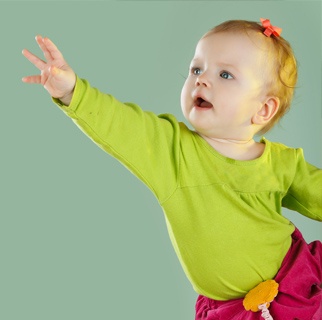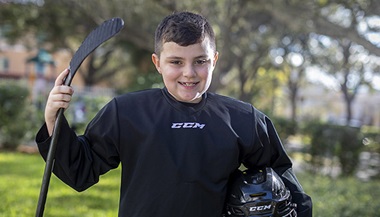The Growing Child: 10 to 12 Months
How much will my baby grow?
While all babies may grow at a different rate, the following indicates the average for boys and girls 10 to 12 months of age:

- Weight: average gain of about 13 ounces each month, birthweight is doubled at approximately 4 to 5 months and tripled at 1 year
- Height: average growth of just over 1/2 inch each month with most infants growing 10 inches in the first year.
- Head size: average growth of about 1/2 inch each month
What can my baby do at this age?
As your baby continues to grow, you will notice new and exciting abilities that develop. While babies may progress at different rates, the following are some of the common milestones your child may reach in this age group:
- Pulls up to a standing position
- Can sit back down from standing position
- Cruises or walks around holding onto furniture
- May stand next to furniture without holding on
- May walk holding on to your finger or hand
- May begin to take steps and walk on own
- Plays ball by receiving and returning a rolled ball
- Able to pick up food and small objects with fingers
- Can feed self finger foods
- Drinks from cup with spout
- Can turn pages in a book, often several at a time
- Bangs objects together
- Imitates scribble
- New teeth continue to erupt; may have 4 to 6 teeth by 1 year old
- Takes 2 naps a day and is able to sleep up to 12 hours at night without a feeding
- Make wake up at night looking for parents
What can my baby say?
Speech development is very exciting for parents as they watch their babies become social beings that can interact with others. While every baby develops speech at his or her own rate, the following are some of the common milestones in this age group:
- Says da-da and ma-ma and knows who these persons are
- Imitates sounds and some speech
- May say things like "Uh oh"
- Imitates animal sounds in response to questions (such as, "What does the cow say?")
- Simple gesture (such as shaking head "no")
What does my baby understand?
Babies at this age become much more aware of others as well as themselves. They are not yet confident that mother will return when she leaves. While children may progress at different rates, the following are some of the common milestones children may reach in this age group:
- Recognizes familiar objects and pictures in books, and may point to some objects when asked "Where is the …..?"
- Follows a one step command with the parent having to show the child how to do it
- Has preferences for people and toys, and may have a favorite toy or blanket
- Is curious and wants to explore
- Moves to music
- Drops objects on purpose for others to pick up
- Points and gestures for objects and actions
- May begin to pretend simple activities, such as cleaning or drinking from cup
How does my baby interact with others?
Separation anxiety and fear of strangers are common at this age. Separation anxiety is anxiousness and fearfulness of being separated from a parent, whether or not the parent is actually leaving the presence of the child. However, this is an important part of the relationship with the parent. While every child is unique and will develop different personalities, the following are some of the common behavioral traits that may be present in your child:
- Fear and anxiety of strangers; may cling and clutch parents; cries when parent leaves
- Waves bye-bye
- Cries or shows emotions when told "no"
How to help increase your baby's learning and emotional security
Consider the following as ways to foster the emotional security of your baby:
- Walk away for short periods while your baby plays in a safe area. This will help to teach him or her that you will come back each time.
- Introduce your baby gradually to new people and things.
- Look at picture books with your baby and talk about the pictures.
- Give your baby finger foods and help him or her to use a spoon, but allow your baby to do it alone. Do not worry if your baby makes a mess. Experimentation is important.
- Read stories to your baby every day.
- When your baby asks for something by pointing, name the object as you give it to him or her.
- Hold and cuddle your baby often.
- Continue a bed time routine of cuddling, rocking, and soothing.
- Respond to your baby if he or she awakens and cries at night. Avoid turning on the light or picking up or holding your baby. Limit your interactions to soothing talk and patting. Tell your baby it is time for sleep.
- Give your child toys that move (such as balls or cars).




